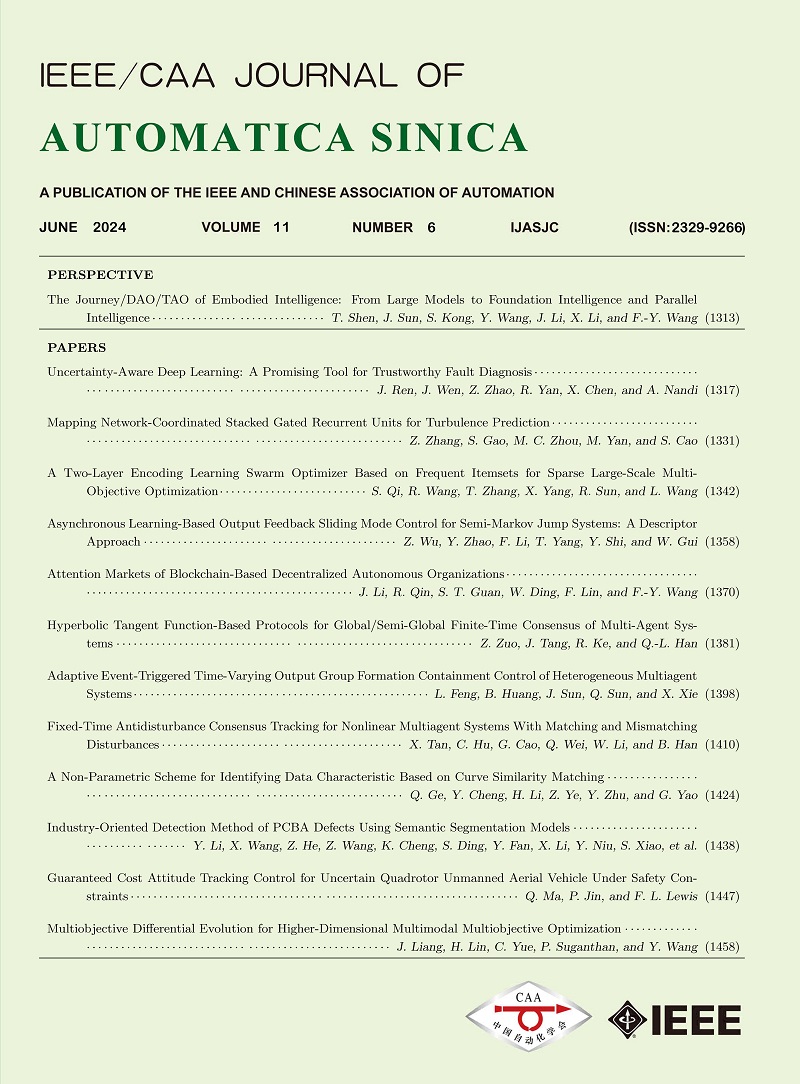 Volume 11
Issue 6
Volume 11
Issue 6
IEEE/CAA Journal of Automatica Sinica
| Citation: | J. Liu, S. Li, and R. Liu, “Recurrent neural network inspired finite-time control design,” IEEE/CAA J. Autom. Sinica, vol. 11, no. 6, pp. 1527–1529, Jun. 2024. doi: 10.1109/JAS.2023.123297 |

| [1] |
W. Yu, “Nonlinear system identification using discrete-time recurrent neural networks with stable learning algorithms,” Inf. Sci., vol. 158, pp. 131–147, 2004. doi: 10.1016/j.ins.2003.08.002
|
| [2] |
W. Yu and X. Li, “Some new results on system identification with dynamic neural networks,” IEEE Trans. Neural Netw., vol. 12, no. 2, pp. 412–417, 2001. doi: 10.1109/72.914535
|
| [3] |
T. Mikolov, A. Joulin, S. Chopra, M. Mathieu, and M. Ranzato, “Learning longer memory in recurrent neural networks,” arXiv preprint arXiv: 1412.7753, 2014.
|
| [4] |
Y. Bengio, P. Simard, and P. Frasconi, “Learning long-term dependencies with gradient descent is difficult,” IEEE Trans. Neural Netw., vol. 5, no. 2, pp. 157–166, 1994. doi: 10.1109/72.279181
|
| [5] |
H. Salehinejad, S. Sankar, J. Barfett, E. Colak, and S. Valaee, “Recent advances in recurrent neural networks,” arXiv preprint arXiv: 1801.01078, 2017.
|
| [6] |
J. Wang, L. Zhang, Q. Guo, and Z. Yi, “Recurrent neural networks with auxiliary memory units,” IEEE Trans. Neural Netw. Learn. Syst., vol. 29, no. 5, pp. 1652–1661, 2018. doi: 10.1109/TNNLS.2017.2677968
|
| [7] |
J. Turek, S. Jain, V. Vo, M. Capotă, A. Huth, and T. Willke, “Approximating stacked and bidirectional recurrent architectures with the delayed recurrent neural network,” in Proc. Int. Conf. Mach. Learn., PMLR, 2020, pp. 9648−9658.
|
| [8] |
X. Liu, J. Zhou, and H. Qian, “Short-term wind power forecasting by stacked recurrent neural networks with parametric sine activation function,” Electr. Power Syst. Res., vol. 192, p. 107011, 2021. doi: 10.1016/j.jpgr.2020.107011
|
| [9] |
Y. Liu, H. Li, Z. Zuo, X. Li, and R. Lu, “An overview of finite/fixed-time control and its application in engineering systems,” IEEE/CAA J. Autom. Sinica, vol. 9, no. 12, pp. 2106–2120, Dec. 2022. doi: 10.1109/JAS.2022.105413
|
| [10] |
S. P. Bhat and D. S. Bernstein, “Finite-time stability of continuous autonomous systems,” SIAM J. Control Optim., vol. 38, pp. 751–766, 2000. doi: 10.1137/S0363012997321358
|
| [11] |
A. Perrusquía and W. Yu, “Identification and optimal control of nonlinear systems using recurrent neuralnetworks and reinforcement learning: An overview,” Neurocomput., vol. 438, pp. 145–154, 2021. doi: 10.1016/j.neucom.2021.01.096
|
| [12] |
R. Liu, S. Li, and S. Ding, “Nested saturation control for overhead crane systems,” Trans. Inst. Meas. Control, vol. 34, no. 7, pp. 862–875, 2012. doi: 10.1177/0142331211423285
|